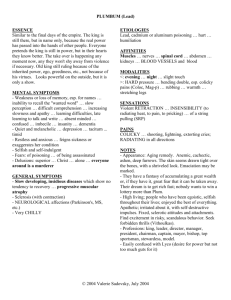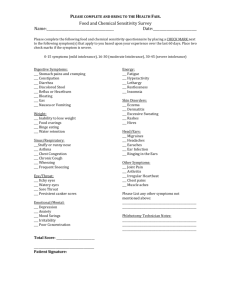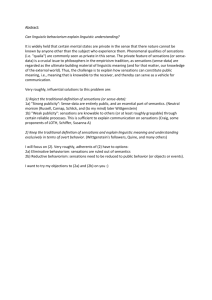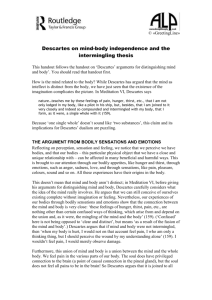Everyday Thinking about Bodily Sensations
advertisement
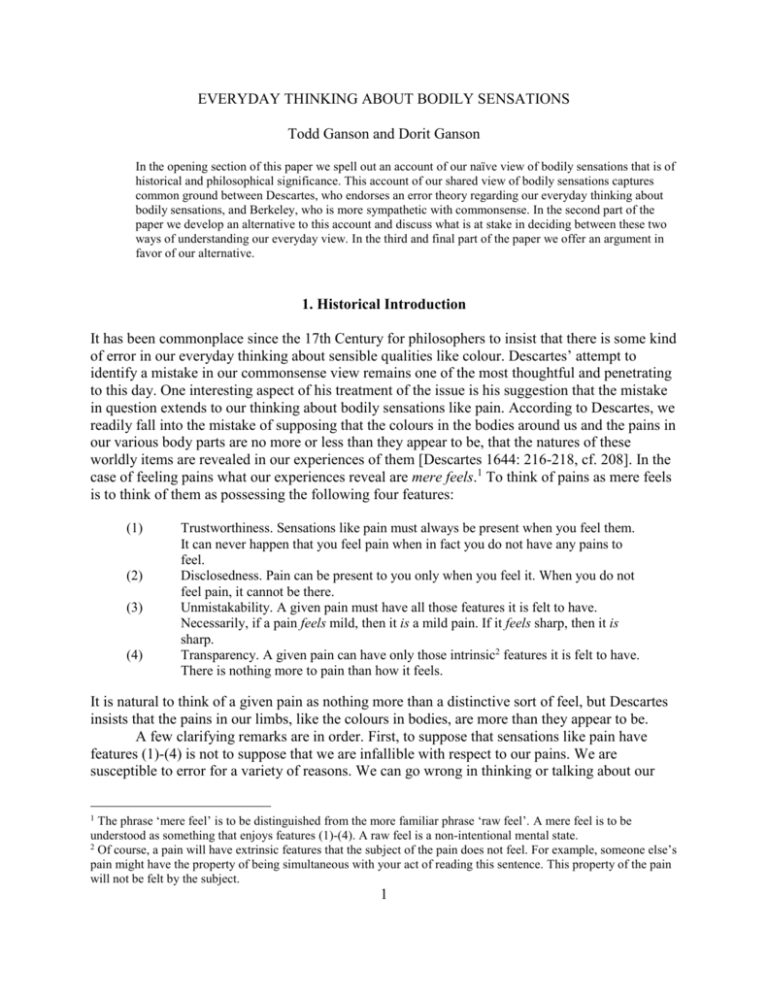
EVERYDAY THINKING ABOUT BODILY SENSATIONS Todd Ganson and Dorit Ganson In the opening section of this paper we spell out an account of our naïve view of bodily sensations that is of historical and philosophical significance. This account of our shared view of bodily sensations captures common ground between Descartes, who endorses an error theory regarding our everyday thinking about bodily sensations, and Berkeley, who is more sympathetic with commonsense. In the second part of the paper we develop an alternative to this account and discuss what is at stake in deciding between these two ways of understanding our everyday view. In the third and final part of the paper we offer an argument in favor of our alternative. 1. Historical Introduction It has been commonplace since the 17th Century for philosophers to insist that there is some kind of error in our everyday thinking about sensible qualities like colour. Descartes’ attempt to identify a mistake in our commonsense view remains one of the most thoughtful and penetrating to this day. One interesting aspect of his treatment of the issue is his suggestion that the mistake in question extends to our thinking about bodily sensations like pain. According to Descartes, we readily fall into the mistake of supposing that the colours in the bodies around us and the pains in our various body parts are no more or less than they appear to be, that the natures of these worldly items are revealed in our experiences of them [Descartes 1644: 216-218, cf. 208]. In the case of feeling pains what our experiences reveal are mere feels.1 To think of pains as mere feels is to think of them as possessing the following four features: (1) (2) (3) (4) Trustworthiness. Sensations like pain must always be present when you feel them. It can never happen that you feel pain when in fact you do not have any pains to feel. Disclosedness. Pain can be present to you only when you feel it. When you do not feel pain, it cannot be there. Unmistakability. A given pain must have all those features it is felt to have. Necessarily, if a pain feels mild, then it is a mild pain. If it feels sharp, then it is sharp. Transparency. A given pain can have only those intrinsic2 features it is felt to have. There is nothing more to pain than how it feels. It is natural to think of a given pain as nothing more than a distinctive sort of feel, but Descartes insists that the pains in our limbs, like the colours in bodies, are more than they appear to be. A few clarifying remarks are in order. First, to suppose that sensations like pain have features (1)-(4) is not to suppose that we are infallible with respect to our pains. We are susceptible to error for a variety of reasons. We can go wrong in thinking or talking about our The phrase ‘mere feel’ is to be distinguished from the more familiar phrase ‘raw feel’. A mere feel is to be understood as something that enjoys features (1)-(4). A raw feel is a non-intentional mental state. 2 Of course, a pain will have extrinsic features that the subject of the pain does not feel. For example, someone else’s pain might have the property of being simultaneous with your act of reading this sentence. This property of the pain will not be felt by the subject. 1 1 pains because of a failure to attend carefully to our feelings of pain, because we do not really grasp the concepts involved, because we accidentally use the wrong words, etc. Presumably mistakes are not that uncommon: people do not always pay careful attention to the character of their feelings, nor do they always use language appropriately when confronted with feelings. The point here is just that the feeling of pain is never mistaken about pain. Second, commitment to transparency (i.e. (4)) involves rejecting the idea that our sensations have a hidden nature. For present purposes, to grasp the nature of a kind is to grasp necessary and sufficient conditions for the presence of that kind. A quality has a hidden nature when a specification of that quality’s nature will state necessary and sufficient conditions for the presence of that kind which make reference to features inaccessible through our everyday modes of inspection. Endorsing transparency involves denying that our sensations have any such inaccessible characteristics. Third, it is important to note that (1)-(4) are deeply interconnected. (1)-(3) are very strong claims about bodily sensations. Necessarily, if one feels a tingle, a tingle is present. There is no possible world in which there is an itch which no one feels. Necessarily, a given pain has all those features it is felt to have. Why are we committed to such strong claims? Our commitment to such strong necessities becomes intelligible provided we are thinking of a given sensation as transparent—as nothing more than that distinctive feel whose character is manifest in experience. If a given sensation is revealed in experience to be just a certain feel, then it is the sort of thing that must be felt (a feel must be felt) and felt just so. Accordingly, there is no mystery about why we take sensations to be just as they feel and to exist when and only when they are felt. Fourth, Descartes is not opposed to the idea that sensations have features (1)-(4). Descartes will not object to the idea that pains are mere feels which possess the further feature: (5) Privacy. No one else can feel your pains; only you can. What he will object to is the view that these private feels possess: (6) Spatial locatedness. Pains, tingles, and the rest are typically located in our various body parts. Putting (1)-(6) together we have a plausible characterization of our pre-theoretical view of bodily sensations. We will refer to this understanding of our everyday view as the ‘Traditional Account’. When Descartes endorses an error theory regarding our everyday view of bodily sensations, he has something like the Traditional Account in mind.3 His complaint is that (1)-(6) do not all belong to the same thing. He thinks we need a distinction that is no part of commonsense, a distinction between pain-as-we-experience-it and pain-in-our-bodies. Only the former is revealed in experience to be a mere feeling.4 3 It is doubtful that Descartes' view of commonsense is so fully worked out. Thomas Reid was perhaps the first to distinguish features (1)-(5) and explicitly attribute them to sensations. See Ganson [2008]. 4 We assume (without argument) that Descartes is a pluralist about pains and colours. He distinguishes two types of colours (colours-as we-experience-them and colours-in-bodies) and two types of pains (pains-as-we-experiencethem and pains-in-our-bodies). For a reading of Descartes as a pluralist about colour see Maund [1995]. On our interpretation of Descartes, colours-as-we-experience-them and pains-as-we-experience-them are mere feels; colours-in-bodies and pains-in-our-bodies are not. 2 So what is wrong, exactly, with this view that sensations have features (1)-(6)? Why do we need something like the distinction between pains-as-we-experience-them and pains-in-ourbodies? Although he does not explicitly mention Descartes, Perkins [2005] offers an insightful critique of commonsense that helps us see why Descartes adopts a revisionary approach to our everyday thinking about pain. We begin with Perkins’ understanding of our ordinary concept. Perkins is sympathetic with David Armstrong’s view that in feeling pain we perceive some sort of trouble in the body [Armstrong 1962]. Further, in feeling pain we deploy a concept of this trouble and so perceive the troubling condition of the body as trouble. Perkins disagrees sharply with Armstrong, however, in his understanding of what concept of trouble we deploy in feeling pain. According to Armstrong, we cognize the perceived condition of the body as some sort of trouble or other—we remain neutral on the specific nature of the trouble. Perkins, on the other hand, insists that we think of the pain sensation itself as the trouble in the body, something whose nature we grasp perfectly well. That is, we take pains to be mere feels that are troubling conditions of the body. Perkins notes a straightforward difficulty with this conception of pain. In the usual case of feeling pain, there is indeed trouble in the body. However, we are presumably misunderstanding the nature of this trouble in identifying it with the pain sensation understood as a mere feel. Presumably the relevant troubling condition of the body is the mind-independent physiological state that is giving rise to the feeling of pain, and the precise nature of this state is not revealed in the feeling. Accordingly, it would be better to think of the state in the body as some sort of trouble or other. And this is precisely the revision in our everyday thinking that Descartes insists upon: As long as we merely judge that there is in the objects (that is, in the things, whatever they may turn out to be, which are the source of our sensations) something whose nature we do not know, then we avoid error… [Descartes 1644: 218] We can still maintain that we know our pain sensations perfectly; we just have to distinguish these mere feels from the pains in our bodies. From the Cartesian attack on the naïve view of bodily sensations, we turn to Berkeley, self-proclaimed defender of commonsense. Berkeley’s view of himself as champion of commonsense can be difficult to make sense of. In particular, his principle esse est percipi seems a poor fit with our pre-theoretical beliefs about sensible things. To appreciate the commonsensical side of his philosophy of perception we ought to view Berkeley as starting out from a naïve account of bodily sensations and then extending this account to all sensible things. This is roughly the strategy of Berkeley’s Three Dialogues, where he describes the view he is combating as follows: Upon the common principles of philosophers, we are not assured of the existence of things from their being perceived. And we are taught to distinguish their real nature from that which falls under our senses. Hence arise skepticism and paradoxes. It is not enough, that we see and feel, that we taste and smell a thing. Its true nature, its absolute external entity, is still concealed. [Berkeley 1713: 167] 3 With his esse est percipi principle, Berkeley is offering an alternative to the ‘common principles of philosophers’ not only regarding the existence of sensible things but also regarding their natures (their esse). His suggestion is that we take pains and other bodily sensations, understood along the lines of the Traditional Account, as our model for thinking about all other sensible items. Once we get rid of the idea that the sensible features of bodies are items whose natures are hidden in the depths and replace it with the idea that what is sensible is no more or less than it appears, we are able to avoid the sort of skepticism to which the common principles of philosophers lead. Berkeley arrives at this alternative by showing how heat and other sensible qualities are no different from pains, whose esse est percipi. Nowhere is Berkeley’s alliance with commonsense beliefs more perspicuous than in his alternative to Descartes’ error theory regarding bodily sensations. With his endorsement of idealism, Berkeley is insisting that (1)-(6) are all true of the same thing.5 Descartes and Berkeley are in broad agreement about the nature of minds and their ideas/sensations; they disagree principally about the character of bodies. Descartes denies that our bodies and the bodies around us possess pains and colours as they are revealed in our experiences. The pains and colours present in bodies are items whose true natures are hidden in the depths and revealed only through scientific investigation. For Berkeley, by contrast, there is nothing more to bodies than those qualities revealed (for what they are) in experience. Some final, brief remarks on Descartes will help to bring out the philosophical interest of the Traditional Account. When, in the Sixth Meditation, Descartes turns a critical eye to the views that he uncritically endorsed earlier in life, there are two commonsense claims that receive special attention. One is the claim that we know just what, say, heat is like. Although it is natural for us to suppose that heat in the fire is just as it appears to be and nothing more, we do best to say that there is something or other in the fire—we know not what—which brings about this familiar feeling of heat in us [Descartes 1641: 57]. The other commonplace idea Descartes is concerned to reject is the idea that one’s body is part of one’s self or perhaps even the whole self [Descartes 1641: 51-55]. Descartes’ most influential argument against this sort of identification is his conceivability argument. We are able to conceive of ourselves as existing in a world without bodies—we have done so already in the First Meditation when we imagined a deceiving demon. On the assumption that what is conceivable is possible, my body cannot be an essential part of me. For I can exist in a world without bodies, while my body, obviously, cannot. A familiar objection to Descartes’ conceivability argument—familiar even in Descartes’ time—is that conceivability is not always a test of (metaphysical) possibility. Little Timmy has just acquired the concept of oxygen and he conceives of a world where there is water but no oxygen. Given the underlying nature of water, what Timmy conceives here is not metaphysically possible. Perhaps the self or mind, too, has a hidden nature. If we knew more about its true nature, we might realize that the self cannot exist in a world without bodies. Descartes needs to show that the mind is different from the heat of the fire and the pain in the foot, both of which, he supposes, have hidden natures. We seem to have better hope of running this sort of conceivability argument if we focus 5 One need not embrace idealism in order to make sense of the idea that (1)-(6) all belong to the same thing. For a different strategy, see Jackson [1977: 80-84]. Jackson underestimates the difficulty of finding a theoretically plausible view of sensations that accommodates all of (1)-(6). Jackson’s own view is that pains (understood as sense-data) are located just where their causes (bodily disturbances) are. This view is quite odd. In the usual case causes have distinct spatial locations from their effects: typically they are contiguous with one another. 4 on a phenomenon like pain understood along the lines of the Traditional Account.6 Confronted with the objection that there may be more to pain than is revealed in our feelings, we can appeal to our shared concept of pain and insist that pain is transparent, not hidden in the depths. Of course, for an argument of this sort to establish mind-body dualism, we would need the further assumption that the pain felt is a mental phenomenon, and it is not obvious that this is the right way to think about pain. The feeling of pain is clearly a mental state, but the feeling of pain is not obviously transparent in our sense. After all, the feeling of pain is not felt; the pain is. The feeling of pain seems to be transparent in a quite different sense, namely, that our sensory awareness passes right through to the pain felt. The intrinsic, non-representational features of the feeling seem not to be accessible in experience. The nature of the feeling is open to investigation. 2. An Alternative to the Traditional Account While the Traditional Account is certainly plausible, it is not the only credible option for understanding our everyday view of sensation. Consider the following alternatives to (1)-(6): (1') (2') (3') (4') (5') (6') In everyday contexts we generally acknowledge the presence of sensations whenever they are felt. For ordinary purposes pain is taken to be present whenever one feels it. In everyday contexts we generally acknowledge the presence of sensations only when they are felt. For everyday purposes pain is assumed to be present only when one feels it. In everyday contexts we generally acknowledge all the features of a sensation that it is felt to have. As far as our usual purposes are concerned, if a pain feels mild, then it is mild. In everyday contexts we generally acknowledge only those intrinsic features of a sensation that it is felt to have. We typically attribute to a given pain only what is revealed in the feeling of it. In everyday contexts we generally allow that each person has a special access to her own sensations. In ordinary circumstances we assume that no one else is in a position to feel your pains. In everyday contexts we generally locate sensations where they appear to be, namely, in feet, backs, etc. For ordinary purposes pain is assumed to be present where one feels it. The qualification ‘in everyday contexts’ here has the same role that it has when we say that in ordinary contexts something counts as smooth provided it feels smooth. Just as the vulgar do not rule out the possibility of purposes which require a more exacting standard of smoothness, so they do not rule out the possibility of purposes which require a more sophisticated conception of itches or of tingles. On this alternative understanding of our everyday thinking about bodily sensation, we (the vulgar) leave open the possibility that researchers might discover a hidden nature to the sensations we feel and make corresponding adjustments to our ordinary practices of ascribing and describing bodily sensations. Such adjustments would be akin to those of a 6 Of course, Kripke [1980: 144-155] employs this strategy in his celebrated attack on the identity theory. 5 technician who needs a more refined measure of smoothness: the technician adopts an amplificative, rather than a revisionary, account of smoothness. Suppose for the moment that in our everyday lives we do not have a fully worked out, settled view about the nature of bodily sensations like pain. We are not committed to identifying pains with mere feels. Why might we be attracted to (1')-(6')? We begin with (1'). There seem to be several factors at work in our everyday practice of taking the feeling of pain as sufficient for the presence of pain. We are assuming here that we have a rather minimal conception of pain as some trouble or other in the body part felt. In the usual case our grasp of the trouble in the body is much too minimal for us to be in a position to correct the deliverances of our pain experiences: we do not know the trouble well enough even to know what to look for. Accordingly, we rely exclusively on our feelings of pain in determining the presence of pain. Now our olfactory experiences likewise yield a rather minimal conception of odours, and yet odours, we think, are not always present when we smell them. But this difference between olfactory experience and pain experience is partly explicable by appeal to (5'): in the case of olfactory experience the intersubjective accessibility of odours sometimes allows us to correct what smell tells us about the presence of odour. Since pains are typically felt only by one individual, we lack this means of correcting the testimony of our pain experiences. Furthermore, through our agency (drawing in air more rigorously, moving about, clearing our nasal passages...) we are sometimes able to correct what our olfactory experiences tell us about the presence of odour. But feeling pain is much less of an activity than smelling odour. In pain experience we are relatively passive. Accordingly, in the case of pain experience there does not seem to be anything to do to correct what our pain experiences are telling us about the presence of pain. All we can do, perhaps, is attend more carefully to our feelings of pain.7 These exceptional limitations in our ability to correct what our feelings are telling us about the events occurring in our bodies are sufficient to account for our commitment to (1'). Consider next our attraction to (2'). We hesitate to speak of unfelt pains because positing such pains typically serves no explanatory purpose. Should phenomena emerge that would best be explained by positing unfelt pains, we surely would not hesitate to posit them. And, indeed, we sometimes do explain events by appeal to unfelt pains, as when we say that someone woke up because of pain. Our commitment to (2'), then, makes good sense.8 We are assuming that perception sometimes involves bodily action (moving one’s eyes, turning one’s head, drawing in breath…) and that it sometimes involves mental action (actively attending). Our claim in the argument at hand is that, in the usual case, bodily action is no part of feeling pain in the way that bodily action can be part of seeing a scene before the eyes. One might go even further and deny that there is anything like active attending involved in feeling pain. We distinguish hearing from listening and seeing from looking on the grounds that listening and looking involve actively attending, while hearing and seeing need not. Given how forcefully pains demand our attention, there may be no room for a distinction akin to that between hearing and listening. However, since we can sometimes actively divert attention from pain, presumably active attention to pain is possible as well. (We are following O’Shaughnessy [2000: 379-380] in using the phrase ‘active attending’ to describe the difference between mere hearing and listening.) 8 Although he does not distinguish (2) and (2'), Langsam [1995] offers an explanation of our hesitation to speak of unfelt pains that fits well with the idea that we are committed merely to (2'). According to Langsam, we generally suppose that pains do not exist unfelt because we do not have anything plausible to say about why we fail to perceive them. This suggestion is promising, but Langsam’s defense of it is incomplete. Langsam is relying here on the general claim 7 6 We turn now to (3'), our general tendency to move from statements about how sensations feel to corresponding statements concerning how they are. Note that the corresponding statements concerning how sensations are serve to classify those sensations. In addition to grouping sensations by the sorts of evaluative-desiderative-behavioral responses that accompany them, we naturally sort sensations into kinds by how they feel. We call some sensations tingly or tingles precisely because they feel tingly and others are called sharp because they feel sharp. So what being sharp amounts to for sensations just is feeling sharp. Accordingly, the move from feeling F to being F seems perfectly trivial in the case of bodily sensations. A bit more needs to be said about why we naturally license inferences from feeling F to being F in the case of sensations. We allow that a surface might feel perfectly smooth and yet fail to be smooth—even in circumstances where no esoteric measure of smoothness is at work. After all, we allow that a subject’s tactile appearance of a surface may be affected by a number of factors, including the condition of the sense-organ. Hence, feeling perfectly smooth is not by itself sufficient for being smooth. Accordingly, more must be said about why in the case of bodily sensations we typically allow that feeling F is sufficient for being F. Consider a closely related issue. A surface may change in appearance in some respect (say, with respect to shape or colour) without undergoing any intrinsic change, but in pain experience a change in feeling or appearance amounts to a change in the kind of pain felt. What accounts for this difference between surfaces and pains? We are often compelled, as agents in the world, to distinguish changes in our perceptual inputs due to our own agency from changes in our perceptual inputs due to changes in the world around us. Our own willed bodily movements regularly bring about changes in how surfaces look with respect to shape, location, size, colour, etc., and in order to interact effectively with items in our environment we need to distinguish these changes in how surfaces appear from those which are due to intrinsic changes in the surfaces of things. Indeed, our ordinary purposes demand that we recognize a variety of factors that influence how surfaces appear: changes in distance, lighting, position, etc.9 By contrast, our ability to influence our perceptual inputs with respect to our bodily sensations is rather limited: we are largely passive observers.10 Our suggestion is that, due to this passivity, we do not have the same opportunities for distinguishing a variety of factors that influence how things feel or appear. We register a change in feeling as a change in the kind of pain felt, and so treat feeling as sufficient for being. that, if we think of objects of some kind as continuing to exist even when we are not experiencing them, it is because we have something plausible to say about why we experience these objects only at certain times, despite their continuing existence. [Langsam 1995: 308] Langsam fails to consider the possibility that we might have good reason to think of a certain item as continuing to exist, even though we are no longer able to perceive it and even though we as yet have nothing plausible to say about why we are unable to perceive it. (Perhaps a trustworthy scientist or oracle has assured us that the item still exists.) He should not assume, without argument, that cases of this sort are impossible. 9 Our claim here is not that a passive individual incapable of any spatial actions would be unable to distinguish these differences in sensory inputs. We are making the more modest claim that such an individual will not have the same need for such a distinction. 10 We are, of course, able to bring about new pains and sometimes we can make pains go away, but we are interested here in the felt character of our pains. On occasion we can alter the intensity of an existing pain by, say, increasing or reducing pressure to the disturbed area, but generally speaking there is very little we can do to affect the felt character of our pains. 7 We now have a plausible explanation of our commitment to (3'). We are not committed to the idea that one cannot in principle distinguish how sensations are from how they appear. Rather, we typically have no use for any such distinction in our everyday practices. By contrast, we have a very pressing need to draw a distinction of this sort when we are dealing with surface properties like shape, colour, size, and location. Our explanation of the appeal of (4') mirrors the explanation we offered in the case of (2'). It would seem that in ordinary contexts nothing is served by attributing unfelt features to pains. If we could best explain some phenomenon by attributing some further features to our bodily sensations, then we would surely do so. Our attraction to (5') is also readily explicable. We discover by experience that we are unable to feel the pains of others. We do not rule out the possibility that some pains are shared. Perhaps some Siamese twins share pains. One might question whether we should think of (5') as an empirical discovery. Perhaps what we mean in saying that a pain belongs to you is just that only you can feel it. In that case it would be an a priori truth that only you can feel your pains. But this way of thinking about the ownership of pain has very little to recommend it. Is it really ruled out a priori that Siamese twins might share one and the same pain? So how should we think about what constitutes ownership of pains? The most obvious suggestion is that your pains are precisely those located in your body. A prima facie problem with this idea is that phantom-limb pains seem to count as pains, though they are not obviously located in any of the subject’s body parts. An alternative proposal, due to Langsam [1995: 304], is that your pains are those that follow your body around wherever it may go. But this suggestion is no better. Suppose that David has an inseparable Siamese twin with a pain in a nonoverlapping body part. This pain, as long as it lasts, will follow David around wherever he may go, though it is not his pain. It is doubtful that this sort of armchair philosophizing will, by itself, reveal what pain ownership consists in. To make progress on the issue we likely need an account of what pains are, and this is partly an empirical matter. We now have before us two plausible ways of understanding our everyday view of bodily sensations. Before we turn to the question of which account is preferable, it is worth asking why we should care about this question. What is at stake in deciding between these two accounts? Two reasons for caring are suggested by our historical remarks in section one above. First, there is the issue of whether we ought to adopt a revisionary approach to our everyday view of sensation. Since Cartesian worries about our everyday view rest on the assumption that we are thinking of pains as mere feels,11 the disagreement between Descartes and Berkeley concerning the viability of our everyday concept of pain presupposes the correctness of the Traditional Account (or something very similar). Hence, part of what is at stake in deciding between the Traditional Account and our alternative is whether we have reason to take Cartesian worries about commonsense seriously. Second, Cartesian conceivability arguments for mind-body dualism take as their startingpoint our commonplace conception of items like pain or the self and then move to claims about what is in fact possible. On the assumption that the core of our commonplace conception of sensation is captured by (1)-(6), conceivability arguments that appeal to sensations like pain 11 Although we have been focusing on the Cartesian critique of commonsense, worries about our everyday concept of pain are pervasive and they typically presuppose something like the Traditional Account. For a helpful survey of the topic, see Aydede [2005: 1-58]. 8 cannot easily be dismissed. We cannot just say—as we might to someone insisting that water could exist in a world without oxygen—that conceivability does not guarantee possibility. For that response is most effective in cases where we allow for the possibility of a hidden nature— something our commonsense notion of pain rules out, according to the Traditional Account. Accordingly, the issue of whether we should favor the Traditional Account or our alternative is clearly relevant to the question of how seriously we need to take these Cartesian conceivability arguments. 3. An Argument against the Traditional Account Suppose for the moment that the Traditional Account and our alternative both fit well with ordinary practices of ascribing and describing bodily sensations. Would we do best to conclude that our everyday thinking is indeterminate between the two accounts? Not necessarily. Our responses to counterfactual scenarios may well speak in favor of one of the two accounts or yet a further account. We may need to employ empirical methods to determine what most people believe—e.g. the sorts of polling methods employed by those practicing Experimental Philosophy (see Appiah [2007]). There is hope, however, that the matter may be settled without turning to empirical research. For it is far from obvious that the Traditional Account in fact succeeds in according with our ordinary practices of ascribing and describing sensations. As a fully general account of our ordinary thinking about bodily sensations, the Traditional Account seems problematic. There are some kinds of bodily sensations—feelings of temperature, swelling, bloating, hunger, thirst, pressure, and muscle contraction—that do not fit well with (1)-(6). Although a feeling of bloating in the lower abdomen is a pretty good indication that one is bloated, no one supposes that bloating must be present when the feeling is. And many of us are familiar with feeling deeply chilled during a fever state. The bloating, swelling, and temperature alterations we feel in our bodies lack trustworthiness as we have defined it. While it is prima facie plausible to suppose that pains enjoy trustworthiness, it does not seem to be true in general that the items we sense in our bodies share this feature.12 This worry for proponents of the Traditional Account leads to an even more serious problem. Why would we treat only some sensations (namely, pains, itches, tingles and the like) as mere feels? There does not seem to be any relevant phenomenological difference between the sensations in question. And given that the phenomenology is the same, won’t we have to say that bloating, swelling, and temperature are likewise revealed to be mere feels and nothing more? But to say that is to move far away from anything commonsensical. On our alternative to the Traditional Account, people do not think of tingles, say, as having a fundamentally different ontological status from the temperatures and swellings we feel. What differs here is just our ability to correct what our feelings tell us. We (ordinary folk) really 12 One might suggest that this objection to the Traditional Account fails because what is felt is not the swelling or muscle contraction. The subject of phantom-limb sensations is feeling something, but she is not feeling swelling or pressure of the limb. There is no limb! Surely ordinary bodily sensations work the same way: what we immediately feel is something other than conditions of the flesh. This response on behalf of the Traditional Account is inadequate. What we have here is a philosophical argument and no part of commonsense. Indeed, the conclusion of the argument seems to be at odds with our naïve, commonsense view that we are immediately aware of states of the body. 9 have no idea what tingles are and so no idea what getting it right (or wrong) amounts to. Our independent grasp of temperature, swelling, and bloating and independent measures of their presence is the key difference. We do not rule out the possibility of similar improvements to our knowledge of pains, tingles, and the like. Although we currently treat our feelings of pain as sufficient for the presence of pain, there is no telling whether improvements to our knowledge may someday give rise to changes in our practices of ascribing pains. One might suggest that our responses to subjects of phantom-limb pains speak against the idea that we would ever move away from taking the sensation of pain as sufficient for the presence of pain. If we were thinking of pain as potentially something more than a mere feeling (e.g. as some physiological state or other), then we would at least hesitate to ascribe pains to subjects of phantom-limb pains. But we do not hesitate.13 On the other hand, it is not entirely clear what to make of our response to subjects with phantom-limb pains. We do not doubt that they are suffering and would not wish to say anything that suggests otherwise. To deny that they have pains comes uncomfortably close to denying that they have discomfort or are genuinely suffering, for we often lump together pain understood as a bodily sensation and the evaluative-desiderative response that pain typically elicits. Even Berkeley is guilty of failing to distinguish these when he writes: ‘An intense degree of cold is a pain; for to feel a very great cold, is to perceive a great uneasiness: it cannot therefore exist without the mind.’ [Berkeley 1713: 178] Berkeley seems to be identifying the intense pain one feels with a great uneasiness, something which clearly cannot exist outside one's mind. This identification does not obviously fit with his view of pain as a mere feel and nothing more: uneasiness is not a sensory feel; it is an attitude. If this sort of confusion is at work in our judgements about subjects with phantom-limb pains, then we have to be careful about appealing to these judgements in trying to sort out our everyday view of sensation. We all surely agree that subjects of phantom-limb pains are uneasy. Perhaps our lack of hesitation in ascribing pain to these subjects is an expression of our sympathy for their suffering and tells us little about our general view of bodily sensation. There is, however, an even more important point to be made here regarding phantomlimb pains. On the account of commonsense that we prefer, the vulgar have no idea what pains are, exactly, and this ignorance leaves us unclear on a number of issues. Can our pains exist where our limbs are not? Do pains (sometimes) exist somewhere other than where they appear to be? Are referred pains cases of this sort? Is phantom-limb pain a special case of referred pain? Without more insight into the nature of pain, we are in no position to decide these issues and have no basis for correcting our feelings when they tell us pains are present. Hence, in our everyday lives we suppose pains are present whenever we feel them—even those that seem to be located where our limbs are not. In sum, the Traditional Account faces a serious problem. On this view we take our feelings to reveal just what pains, tingles, and itches are—they are just certain feels and nothing more. But if that is how we think about pains, tingles, and itches, then surely we will think the same way about other items we feel in our bodies—temperature changes, bloating, swelling, etc. 13 We suspect that the line of reasoning here has played a significant role in convincing philosophers that the Traditional Account succeeds in capturing what the commonsense view is: they suppose typical responses to phantom-limb patients are best explained on the assumption that people are thinking of bodily sensations as trustworthy (in the sense defined above). Our alternative suggestion, developed below, is that people react the way they do to phantom-limb pains largely because they lack clarity regarding the nature of pain. 10 After all, there is no relevant phenomenological difference here: if the former are fully revealed for what they are in our feelings of them, then the latter are as well. In fact, though, we do not treat the latter as mere feels. Something has gone wrong here. On our view, the Traditional Account has principally gone wrong in its insistence that we take the natures of bodily sensations to be fully revealed in our feelings of them.14 Oberlin College References Appiah, Kwame Anthony 2007. The New New Philosophy, The New York Times 12/9/2007. Armstrong, David M. 1962. Bodily Sensations, London: Routledge and Kegan Paul. Aydede, Murat 2005. Pain: New Essays on Its Nature and the Methodology of Its Study, Cambridge: MIT Press. Berkeley, George 1949 (1713). Three Dialogues between Hylas and Philonous, in The Works of George Berkeley, Bishop of Cloyne, ed. A. A. Luce and T. E. Jessop, vol. 2, London: Thomas Nelson. Descartes, René 1984 (1641). Meditations on First Philosophy, in The Philosophical Writings of Descartes, trans. John Cottingham, Robert Stoothoff, and Dugald Murdoch, vol. 2, Cambridge: Cambridge University Press. Descartes, René 1985 (1644). Principles of Philosophy, in The Philosophical Writings of Descartes, trans. John Cottingham, Robert Stoothoff, and Dugald Murdoch, vol. 1, Cambridge: Cambridge University Press. Ganson, Todd 2008. Reid’s Rejection of Intentionalism, Oxford Studies in Early Modern Philosophy 4: 245-263. Jackson, Frank 1977. Perception, Cambridge: Cambridge University Press. Kripke, Saul 1980. Naming and Necessity, Cambridge: Harvard University Press. Langsam, Harold 1995. Why Pains Are Mental Objects, The Journal of Philosophy 92/6: 303-313. Maund, Barry 1995. Colours: Their Nature and Representation, Cambridge: Cambridge University Press. O'Shaughnessy, Brian 2000. Consciousness and the World, Oxford: Oxford University Press. Perkins, Moreland 2005. An Indirectly Realistic, Representational Account of Pain(ed) Perception, in Aydede: 199218. 14 Special thanks to three anonymous referees for valuable written comments. Thanks also to Murat Aydede and Colin Klein for discussion of the issues. 11



